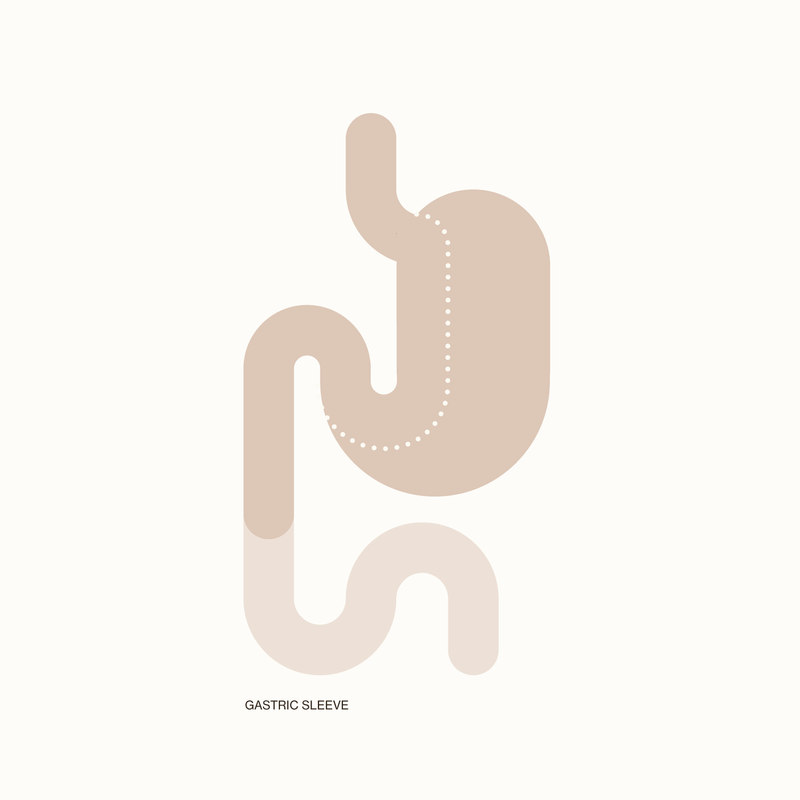WHAT IS A SLEEVE GASTRECTOMY?
The Sleeve Gastrectomy (also referred to as the gastric sleeve, vertical sleeve gastrectomy, or VSG) is the most commonly performed weight loss procedure both in Australia and worldwide. It is also a commonly performed procedure by Dr George Balalis, along with the gastric bypass.
It involves significantly decreasing the stomach size, by removing approximately 80% of the stomach over a 36F bougie (plastic tube). The procedure is performed laparoscopically or ‘keyhole’ under a general anaesthetic.
It is very important that the sleeve is performed correctly, without any twisting or narrowing. This ensures no swallowing difficulties or reflux symptoms.
The other major concern is a staple line leak, which is incredibly rare. And studies show this is less likely when performed by an experienced surgeon.
Dr Balalis is a high volume bariatric surgeon, who regularly performs sleeve gastrectomy operations.
Although the physical size of the stomach is reduced, the normal direction of the food stream through the stomach and the rest of the intestinal tract is not altered. This means that nutrients including vitamins, minerals and protein will continue to be absorbed in the small intestine normally.
A sleeve gastrectomy does decrease the holding volume of the stomach – from around 1.5L to approximately 200mls. This allows a person to feel satisfied, with a meal size approximately equivalent to a cup of food, such as a typical entree.
A sleeve gastrectomy patient will usually have between 4-6 small meals per day. Dietitian’s recommend small frequent meals as a way of avoiding big swings in Insulin levels and achieving a more even intake of calories, as part of a healthier eating pattern.
HOW DOES A SLEEVE GASTRECTOMY WORK?
The procedure appears to work in three different ways:
- Portion control – 80% of the stomach is removed, decreasing the capacity of the stomach, which means patients are full and satisfied with a much smaller meal.
- Hunger Reduction – The fundus of the stomach is removed, which is the part of the stomach rich in cells that produce Ghrelin. Ghrelin is a ‘hunger hormone’ and patients experience less following a sleeve gastrectomy.
- Metabolism – There are a number of other changes that may be part of the benefits of a sleeve gastrectomy, including changes to your gut bacteria and gut hormones.
WHO IS ELIGIBLE FOR THIS PROCEDURE?
Guidelines for sleeve gastrectomy include:
- Age 18-65
- BMI 30 with weight related comorbidities
- Or BMI ≥ 35 with no comorbidities needed
- Patient who has tried other avenues without success
- No alcohol or drug dependency
- No untreated psychiatric disorders
- Is committed to a healthy lifestyle and lifelong care
Note: these are guidelines, and all patients require a discussion regarding sleeve gastrectomy surgery
WHAT ARE THE RISKS OF THIS PROCEDURE?
The main risk of a sleeve gastrectomy is a leak from the staple line, as the stomach is divided and removed. This is very rare, at < 0.5% Australia wide. Treatment may include the use of antibiotics, endoscopy, radiological procedures or even further surgery.
It is always important to detect these issues early. And this is part of the reason why Dr Balalis performs post-operative assessments for all his patients.
He undertakes a CT abdomen with oral contrast before you leave hospital to ensure normal passage of contrast prior to upgrading your diet. Dr Balalis also sees his patients regularly before they are discharged.
Other risks include bleeding, internal injuries, blood clots in leg veins, intestines or lungs. They can also include infection of the abdomen, chest or wounds and reaction to the anaesthetic. These are problems that can occur with any surgery, and all safety measures are taken to minimise these risks.
